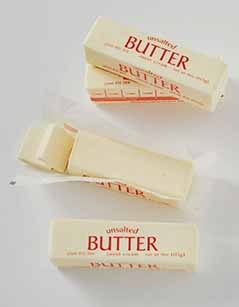
May 2005
Updated June 2022
|
 |
Butter Glossary
Terms & Definitions: T To Z
Butter terms beginning with T to Z, including truffle butter, USDA butter grades, unsalted butter, and whipped butter. If you’d like to suggest other terms, use the Contact Us link on this page. This is Page 7 of a seven-page glossary. Click on the black links below to visit other pages. Enjoy a wealth of food knowledge in our 100+ different food glossaries.
TABLE CREAM or COFFEE CREAM
Light cream, containing 18% to 30% butterfat.
TOCOPHEROL
An antioxidant that is used to decrease the oxidative rancidity of fat or oil. A natural antioxidant, it improves oxidative stability.
TRUFFLE BUTTER
Sweet butter mixed with black or white truffle peelings. The truffles provide rich truffle flavor and aroma, and the butter can be used with eggs, pasta, vegetables, rice, or simply enjoyed on bread. Read our review of D’Artagnan truffle butter.
USDA STANDARDS FOR GRADES OF BUTTER
The U.S. Department of Agriculture (USDA) grades butter quality based on flavor characteristics and rates it according to its body, color, and salt. A final grade is assigned based on the combination of all four attributes. Grades include AA, A, and B. Only the best, Grade AA, is available for consumer purchase; the rest is used commercially. All butter sold in the United States must be made from real dairy cream and contain at least 80% milkfat. The butter you see on store shelves has met strict requirements set and enforced by the USDA for quality, performance, appearance, and flavor.
U.S. GRADE AA
Most commonly found at retail, Grade AA butter is the finest (a 93 score), made from sweet cream, and has a smooth, creamy texture. It is easy to spread and has a light, fresh flavor. It can be lightly salted.
U.S. GRADE A
Grade A butter is the second-best grade (a 92 score) and is often found at retail. Like Grade A butter, it is made from fresh cream but has a slightly stronger flavor. It has a fairly smooth texture.
U.S. GRADE B
Grade B butter (a 90 score) can be used by consumers for table use but is generally sold in bulk. It is usually made from sour cream and is more coarse in texture.
UNSALTED BUTTER
This is butter that contains no salt and is sometimes erroneously called sweet butter (see sweet cream butter). It is generally preferred for cooking and baking since it enables the salt level to be adjusted according to the preference of the cook. However, unsalted butter is more fragile: salt is a preservative, and salted butter is less perishable. While unsalted butter remains fresh in the fridge for a month, unsalted butter remains fresh for double that.
VITAMIN A
Butter contains about 3,000 IU of vitamin A per 100 grams or 153 IU per serving (1 pat/ 5 grams).
WHEY BUTTER
A specialty product made from the whey drained from cheese curds. It is strong and salty with a cheesy flavor.
WHIPPED BUTTER
Butter that has had air or other acceptable gases (e.g., nitrogen) whipped into it, resulting in a product with greater volume, and improved spreadability at colder temperatures. It is also lighter with reduced density, which means that for the same size portion, it is lower in fat and has fewer calories. Whipped butter typically is packed in tubs or cups. Whipping improves the spreadability of butter, but it should not be substituted for regular butter in baking. You can make it yourself: Just get out your electric mixer and beat some butter with a little milk or water for a couple of minutes.
WHITE SAUCE
A term for light white or blond sauces. In its simplest form, white sauce is cream or milk mixed into a white roux (a combination of butter and flour which isn’t browned). This basic French sauce is called béchamel. See butter sauce.
WHOLE MILK
Regular milk. Whole milk has close to 4% milkfat (butterfat).
Go To The Article Index Above
Some content courtesy of Cornell University School of Agriculture, Wisconsin Milk Marketing Board, U.S. Department of Agriculture.

|




